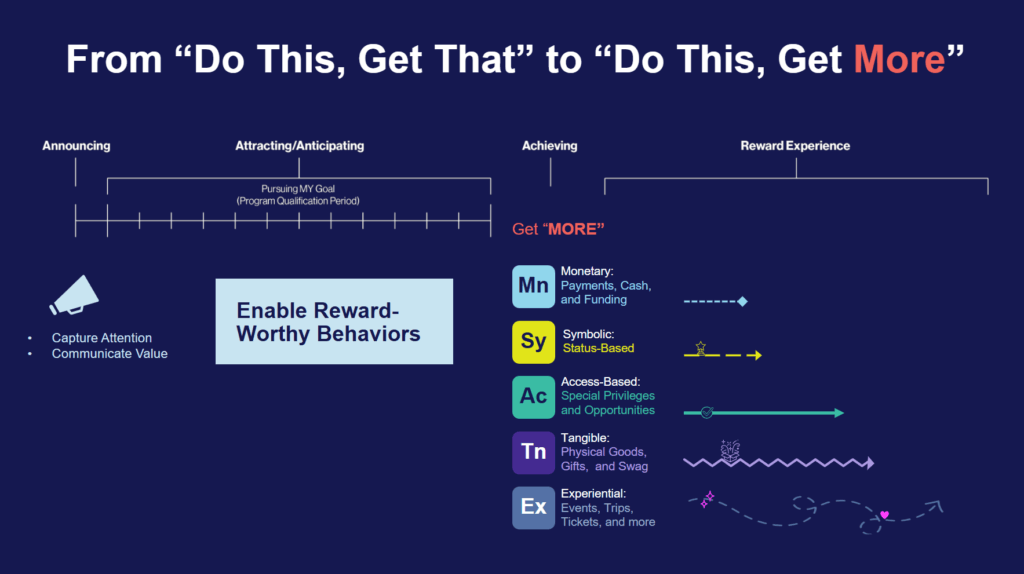
Incentives Make a Measurable Impact
Maritz recently conducted a comprehensive market study to understand experiences, preferences and the factors that drive engagement within channel incentive programs. Here are some of the standout findings:
- 91% of sellers believe incentives have a significant influence on their motivation to sell
- 92% of sellers agree that participation in incentives contributes positively to their business success
- 93% of sellers felt a greater connection to the sponsoring brand
- 92% of sellers felt more confident when selling the sponsoring business’ products
- 83% of participants said a reduction in program benefits would negatively impact their engagement and sales efforts
Read the full Insights Report here: Maritz Channel Incentives Insights Report: Protecting Your Budget, Boosting Your Returns For 2025 & Beyond

These stats likely don’t come as a surprise. Incentive programs have proven their worth time and again. However, even the most established and successful programs are occasionally scrutinized. Is the program still delivering results? Should we continue to invest? If skeptics are in the room, these insights help you jump past those questions and move the conversation toward improving your program.
Incentive Programs Work, BUT...
There’s a big gap between high-performing and subpar incentive programs.
Success is primarily defined by these factors – what participants love about the best programs and what they dislike about the worst ones. Decades of experience designing these programs align with what our market study participants shared:
What participants love about the best programs:
- Value and variety of rewards (there’s something for everyone)
- Opportunities to develop new skills or grow professionally
- Ease of use with clear rules (a seamless design works behind the scenes)
- Strong communication, including progress tracking and relevant updates
What participants dislike about the worst programs:
- Poor-quality rewards
- Confusing rules
- Irrelevant or infrequent communication
Read the full best practices report here: Maritz Channel Incentives Insights Report Part Two: Be the Best: Defining Exceptional Channel Incentive Programs.

So, How Do You Build More Effective Incentive & Loyalty Programs?

Exceptional programs are built at the intersection of data, science and design.
- Data: Measure and optimize the metrics that drive true program success. This is often beyond just surface level transactions and revenue growth. Additionally, insights from research, like the Maritz study, can reveal what matters most to participants. Consider conducting surveys of your own.
- Science: Leverage behavioral science to influence desired behaviors. This involves understanding the psychological factors that drive human actions.
- Design: Create holistic programs that enable, engage and motivate. Strategic design includes thoughtful rule structures, incentives and rewards and engaging communications.
Data – Measure and Optimize the Metrics That Deliver True Program Success
- Outcomes (What you achieve): These are the ultimate goals of your program.
- Increased sales revenue and transactional numbers
- Business growth in areas like market share, average deal value and purchase frequency
- Actions (How you get there): These are the specific steps and activities that contribute to your success.
- Skill Building & Learning: Knowledge and skills gained by participants through the program.
- Program Engagement: Active participation in onboarding, surveys, promotions, even platform logins and email opens.
By analyzing both outcomes and actions, you gain a comprehensive understanding of your program’s effectiveness and can identify areas for improvement.
Ideas for Optimization
- Balance stable and variable incentives for sustained motivation. A foundational “base” incentive keeps participants engaged, while periodic promotions create excitement.
- Set stretch goals with ambitious but achievable targets.
- Understand your audience and the associated bell-curve (the typical distribution of performance). Engage middle performers with tailored strategies or create elite tiers that top performers can aspire to reach.
Science: Use the Behavioral Science of Goal Setting to Influence Actions
Behavioral science offers valuable insights into human motivation, particularly when it comes to goal achievement. Two key principles can significantly impact program effectiveness:
Design: Create Holistic Programs That Enable, Engage and Spark Motivation
Exceptional programs don’t just focus on the award or trip itself, they prioritize the entire program experience, from announcement to rewards.
Phases of the Program Experience
- Announcing: Capture attention and communicate value.
- Attracting & Anticipating (Program Qualification Period): Enable behaviors that are reward-worthy.
- Achieving: Celebrate accomplishments and milestones.
- Experiencing the Rewards: Create maximum impact through diverse, memorable rewards.

Diverse Reward Options for Exceptional Experiences
We use a five-category framework to understand different types of rewards and their impacts.
Each type is designed to tackle a different challenge, so you’ll need to examine what behaviors you are motivating to pick the right one for the job. There’s a powerful link between the kind of behaviors (like transactional vs relationship-focused) and the types of incentives that would be most effective to drive those behaviors.

Monetary: Cash, Rebates & Discounts
While financial rewards are effective, they’re just one piece of the puzzle. A well-rounded program also incorporates non-monetary incentives to create a more engaging and holistic experience.
Symbolic: Status, Tiers & Recognition
Symbolic rewards tap into instrinsic motivatiors like pride and accomplishment. They can include invitations to exclusive “Champions Clubs,” public shout-outs or personalized certificates. These rewards resonate deeply and provide ongoing motivation, as people often work harder to maintain earned status.
Access Based: Exclusive Opportunities & Privileges
Limited-access rewards, like early product launches, premium support or “inner-circle” access, build perceived value through scarcity and exclusivity. For example, being the first to sell a new product or having direct lines to expert resources fosters a sense of importance and loyalty.
Tangible: Physical Goods, Gifts & Swag
Typically merchandise or gifts offered through a points redemption catalog, tangible rewards serve as lasting reminders of success. The key is selecting desirable, high-quality items like coveted swag, cutting-edge gadgets or lifestyle accessories that participants are proud to showcase.
Experiential: Trips, Events & Unforgettable Moments.
Experiences create emotional connections and lasting memories, leaving participants with a “memory halo” that reinforces positive feelings toward your brand. Whether it’s a luxurious getaway or a unique team-building event, experiential rewards stand out for their ability to inspire and delight.
Closing Thoughts
Incentive programs are a powerful tool for driving engagement, loyalty and performance. By combining the insights of data, the principles of behavioral science and thoughtful design, you can create programs that don’t just meet expectations by exceed them.


